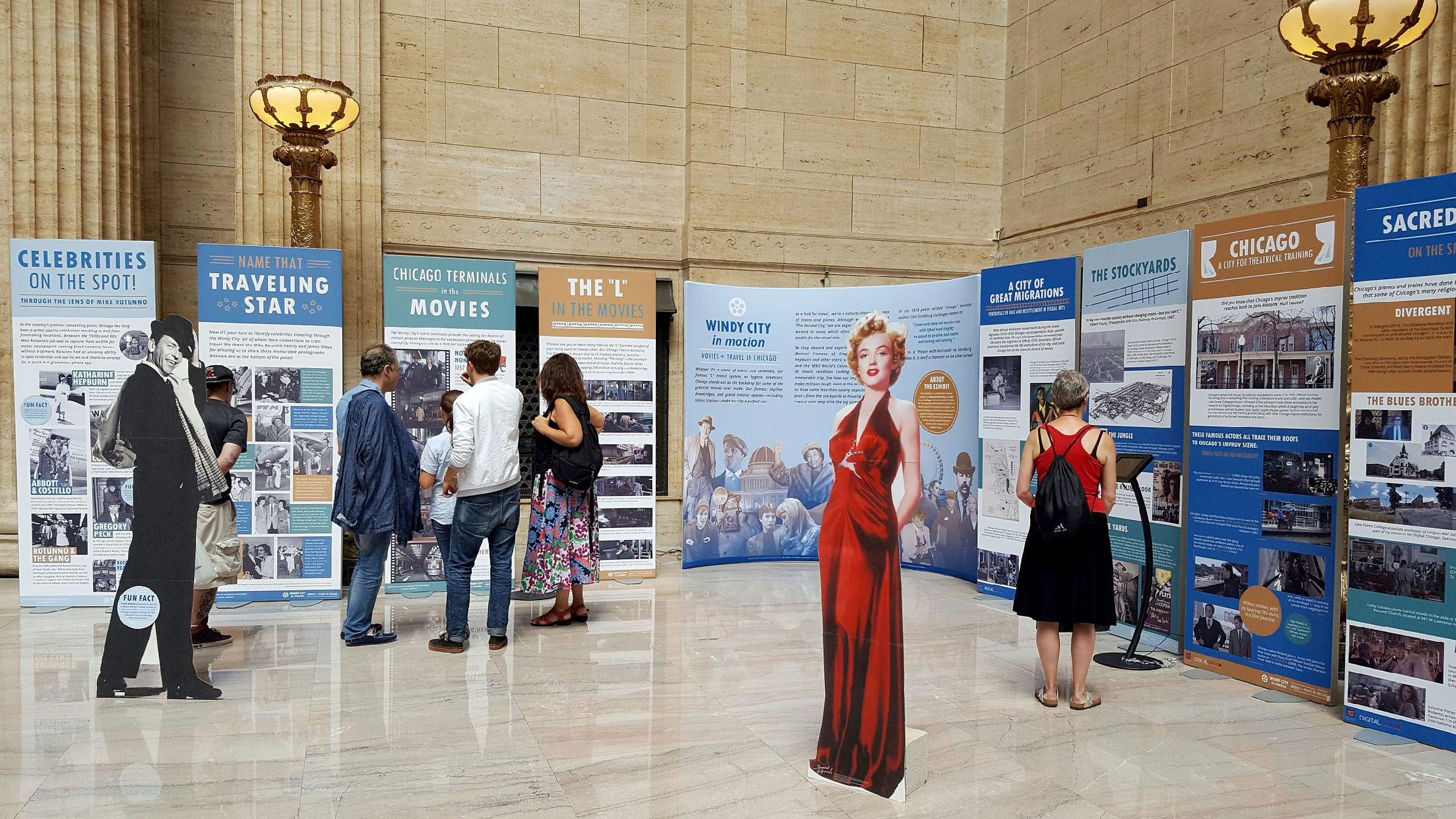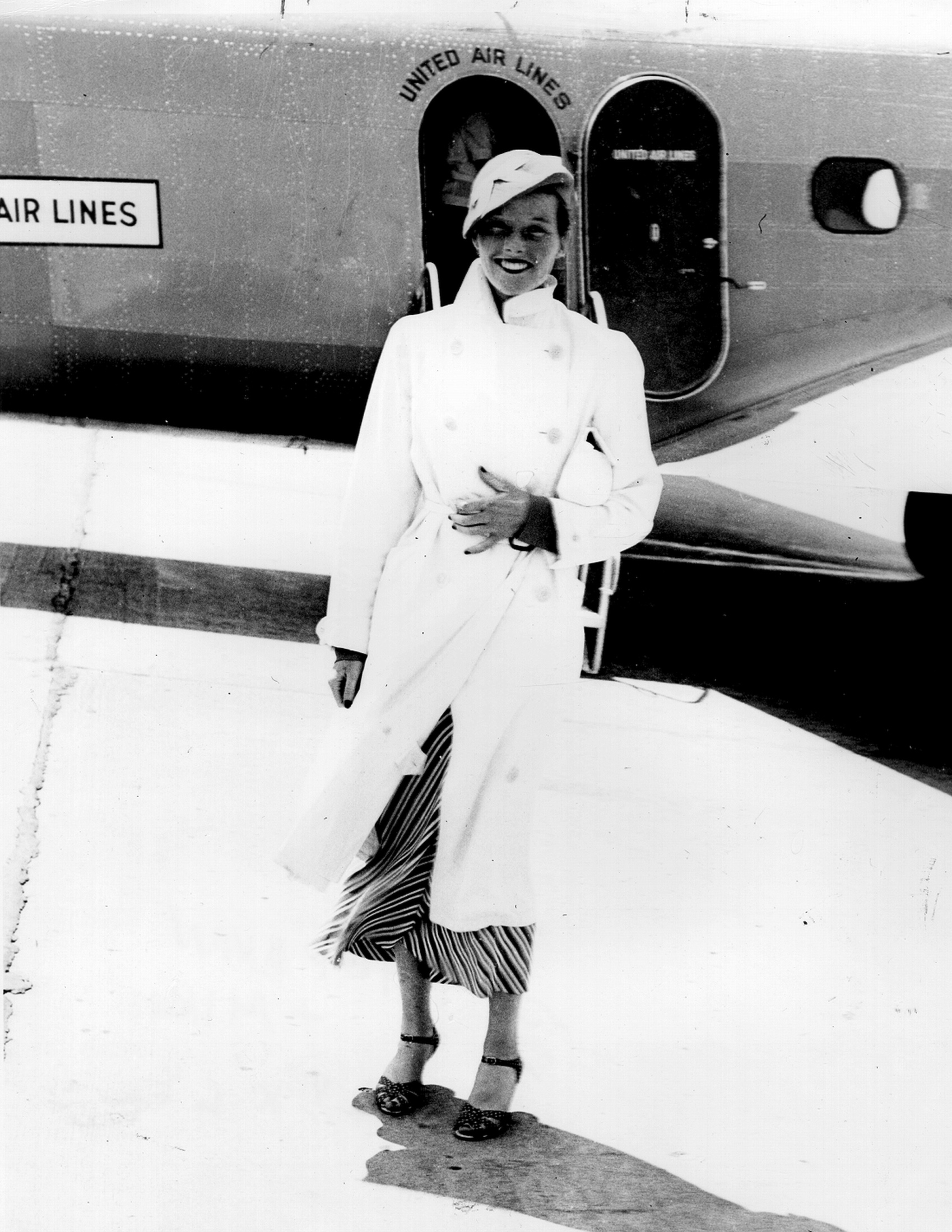 Visitors and commuters at Chicago’s Union Station peruse the “Windy City in Motion: Movies + Travel in Chicago” exhibit, a collaboration between DePaul University and Lake Forest College. Faculty contributed research on religion, film, theater and Chicago history to the 10 panels on display in the Great Hall. (DePaul University/Rachael Smith)
Visitors and commuters at Chicago’s Union Station peruse the “Windy City in Motion: Movies + Travel in Chicago” exhibit, a collaboration between DePaul University and Lake Forest College. Faculty contributed research on religion, film, theater and Chicago history to the 10 panels on display in the Great Hall. (DePaul University/Rachael Smith)CHICAGO — When filmmakers choose Chicago as the setting for iconic movies, the city’s transportation network often plays a starring role. There was the rumble of the ‘L’ train in “Batman Begins” and the chaos of holiday travel at O’Hare International Airport in “Home Alone.” In a new, free exhibit, faculty from DePaul University and Lake Forest College explore the city’s history and urban character through classic motion pictures.
Viewers can take in vintage photos of movie stars, clips and commentary on films, and little-known facts about Chicago’s movie history at “Windy City in Motion: Movies + Travel in Chicago,” which is now on display in the Great Hall at Union Station, 225 S. Canal St. An opening reception is planned for Tuesday, Sept. 13 from 4:45-6 p.m. at the same location.
“Travelers are often attracted to Chicago by how it is portrayed in film,” said Joseph Schwieterman, professor and director of the Chaddick Institute for Metropolitan Development at DePaul. “This exhibit delves into our city’s history as a travel center and destination for film. It also touches on an exciting experience — taking you back to memorable scenes from your favorite movies.”
It is hard to envision a better location for this exhibit that the Great Hall in Chicago Union Station,” said Rachael Smith, the exhibit’s curator and program manager at the Chaddick Institute. “It is one of America's grandest interior spaces, and the scene of many important movie moments.”
The exhibit includes gems of Chicago history — like Hull House’s role in stoking Chicago’s improv comedy scene — from faculty members at Lake Forest College through the Digital Chicago: Unearthing History and Culture project. “We’re rediscovering the connections that have been here all along and that are at risk of being forgotten. Everything we love about improv comedy has Chicago roots that run deep, and that comes through in many classic films,” said Davis Schneiderman, associate dean and director of Digital Chicago.
Commuters and visitors passing through the Great Hall can peruse 10 sections of stories, photos and scholarship. Subjects include:
Terminals in scenes from iconic films
A baby carriage bumps down the stairs of Union Station in “The Untouchables.” Eva Marie Saint and Cary Grant elude police between trains at LaSalle Station in “North by Northwest.” Chicago’s terminals appear in dozens of other famous films, and the exhibit offers insight on these hubs from Schwieterman, author of “Terminal Town: An Illustrated Guide to Chicago's Airports, Bus Depots, Train Stations, and Steamship Landings, 1939-Present” (Lake Forest College Press).
 Actress Kathryn Hepburn arrives at Midway Airport, and roving photographer Mike Rotunno snaps her photo on the tarmac. Rotunno’s photos are part of the “Windy City in Motion: Movies + Travel in Chicago” exhibit. (Image courtesy of the Rotunno Family Foundation)Vintage celebrity photography
Actress Kathryn Hepburn arrives at Midway Airport, and roving photographer Mike Rotunno snaps her photo on the tarmac. Rotunno’s photos are part of the “Windy City in Motion: Movies + Travel in Chicago” exhibit. (Image courtesy of the Rotunno Family Foundation)Vintage celebrity photography
Roving cameraman Mike Rotunno photographed celebrities passing through Chicago’s terminals from the 1920s to the 1980s. The exhibit features his glamorous snapshots of actors John Wayne, Katharine Hepburn and others in locales including Chicago Midway International Airport. The airlines and train lines allowed Rotunno in the terminals, as long as his photos featured their logos.
Chicago locations in starring roles
Alongside transportation hubs, religious sites in Chicago feature prominently in many films. Ben Zeller, associate professor of religion at Lake Forest College, highlights the role of Pilgrim Baptist Church in "The Blues Brothers" and Fourth Presbyterian Church in "My Best Friend's Wedding." Chloe Johnston, assistant professor of theater at Lake Forest College, looks at some of these same films to find the history of ensemble-generated and improv theatre in Chicago.
‘The Devil in the White City’ and history through film
Lake Forest College faculty explore films and theatre that take place in the city in a series of historical panels. In “Beyond the White City,” music professor Don Meyer connects music as it would have been heard at the 1893 World’s Columbian Exposition to the much-anticipated upcoming release of the film adaptation of Erik Larson’s novel “The Devil in the White City.” Ben Goluboff, an associate professor of English, examines the work of Kenneth Sawyer Goodman, the playwright for whom the Goodman Theatre was named. In “A City of Great Migrations,” Desmond Odugu, an assistant professor of education, describes movies about the historic migration of African Americans to Chicago.
Support for Digital Chicago: Unearthing History and Culture is provided by a grant from The Andrew W. Mellon Foundation. Digital Chicago engages faculty and students in innovative digital history projects, urban archaeology and coursework about Chicago’s history. More information at
https://www.lakeforest.edu/digitalchicago/.
The Chaddick Institute at DePaul contributes research and educational programs that enable visionary planning, explained Schwieterman. “Chicago's enormous transportation system really comes to life in film, and this exhibit will provide a thought-provoking experience about the city’s future,” he said. To learn more, visit
http://bit.ly/chaddickDPU.
###
312-241-9856